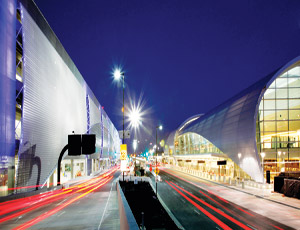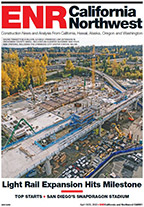After scaling back its expansion plans in the face of spiraling construction costs, Norman Y. Mineta San Jose International Airport, referred to as SJC, is putting the finishing touches on a three-year, $1.3-billion design-build construction program that demonstrates how less really can be more.

The program’s centerpiece—the sleek new 127,000-sq-ft metal-and-glass-paneled Terminal B—began full operation on June 30 as well as a 1.6 million-sq-ft, seven-level precast consolidated rental car and public parking garage, which is known by the acronym ConRAC.
Last fall, SJC completed the modernization of its 14-gate Terminal A with system and aesthetic improvements, plus 56,000 sq ft of new space for ticketing lobbies, expanded security checkpoints and a federally funded, state-of-the-art automated in-line baggage screening system that can handle 1,800 bags an hour.
SJC is one of the first airports to implement the next generation of technology that allows bags to be scanned while moving. The airport received $41 million in federal grants to design and build the systems in both terminals.
The local office of Denver-based Fentress Architects designed Terminals A and B and the ConRAC as well as interim improvements to the 45-year-old Terminal C. That terminal will be demolished as the program wraps up over the next several months with completion of improvements to the internal road network and the addition of new surface parking lots.
The City of San Jose had bigger things in mind for Silicon Valley’s main aviation hub when it kicked off its original development program in 2004 with the 376,000-sq-ft North Concourse project designed by San Francisco-based Gensler, with Gilbane Building Co., Providence, R.I., serving as construction manager.
But the uncertainties of funding a ten-year build-out of design-bid-build projects, already estimated to cost $4.5 billion, led San Jose’s City Council to reassess and rescope the program a year later. The result was a slimmed-down improvement plan that used negotiated design-build to expedite delivery of new facilities to support 14.4 million passengers a year.
SJC planning and development director Dave Maas says the strategy shift to design-build also helped SJC achieve the critical goal of managing a complex mix of concurrent construction projects in a constrained area without disrupting land-side or air-side operations.
Richard Tucker, vice president with Hensel Phelps Construction Co., the design-build team leader, says it was a key decision. “The critical thing was the City of San Jose’s decision to have one entity responsible for coordination on a project that had several main components—each with multiple moving parts of its own,” he says.
The design-build team met constantly with program manager URS Corp., San Francisco, and SJC’s operations department to strive for three years of virtually “surprise-free” construction. “Everyone involved had realistic expectations and set realistic schedules for achieving them,” Maas says.
Savings from the project team’s efficiencies enabled SJC to restore previously deleted construction items, such as upgrades to Terminal A’s HVAC system and high-end flooring and finishes in Terminal B. The latter, with the previously completed North Concourse, is 503,000 sq ft. It is Leadership in Energy and Environmental Design-certified Silver.
Terminal B features the nation’s first implementation of Zenky Air Chairs, which more efficiently circulate air throughout the terminal and provide fresh air directly to travelers from below each seat. The Air Chairs also have individual power outlets for charging travelers’ laptops and mobile devices.
Another savings-funded addition is a 1.12-Megawatt solar array on the roof of the rental car center; it will provide at least 20% of the structure’s power. Covering 3.4 acres, the 4,680-panel array is one of the largest airport solar electric installations in the U.S.




Post a comment to this article
Report Abusive Comment